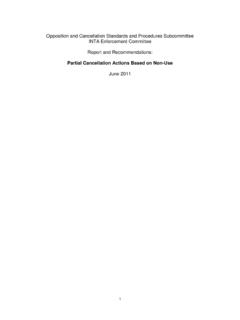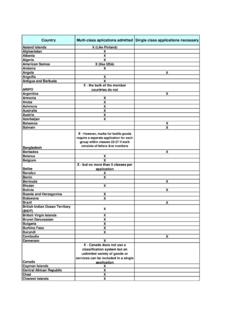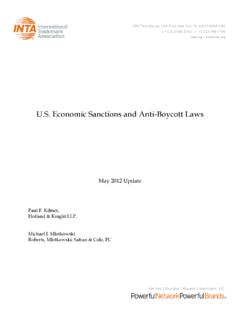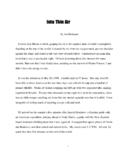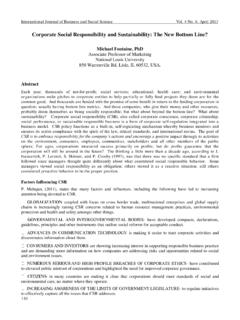Transcription of Christopher R. McElwain
1 High Stakes: Marijuana Brands and the USPTO's [Lawful] Use Registration Criterion Christopher R. McElwain I. Introduction In his history of Prohibition, author Daniel Okrent writes about the black market's effects on American drinking habits: Speakeasy liquor could have been anything from single-malt Scotch smuggled by way of Nassau to diluted embalming fluid.. In the saloon era, calling for liquor by brand name was almost unheard of; in the speakeasy era, it became a habit, first as a means of protecting oneself from alcohol of questionable origin, and secondarily as a way pf expressing one's level of taste.
2 When he was building his own brand, Tommy Dewar publicized the perilous alternative the liquor of unknown provenance he once characterized as squirrel whiskey, so called because, he said it will make men nutty and climb trees. It will send the average Sunday School teacher walking ten miles through three feet of snow to shoot his own parson. Naturally, there was an alternative: Drink Dewar's! Decades later, many of the liquor industry's best-known brands owed their prominence to the ubiquity of Prohibition-era During Prohibition, in a black market flooded with back-alley moonshine and poisonous denatured industrial alcohol,2 consumers clung to trademarks as a shorthand for quality.
3 Unfortunately, counterfeiting was predictably widespread, as bootleggers routinely refilled bottles of brand-name imports with whatever they could lay their hands [I]n too many place, Okrent writes, if you ordered Brand X, you got Brand X; if you ordered Dewar's or Gordon's, you paid twice as much and got Brand X. 4. Nearly a century later, a similar situation has arisen. Twenty-three states and the District of Columbia have passed laws legalizing marijuana for medical use, and four states and have legalized the drug for recreational use as Several other states are expected to vote on 1.
4 Daniel Okrent, LAST CALL: THE RISE AND FALL OF PROHIBITION, 209-210 (Scribner 2010). 2. Edward Behr, PROHIBITION: THIRTEEN YEARS THAT CHANGED AMERICA, 163 and 222 (Arcade Publishing 1996). 3. Id. (noting that in 1926, over 660,000 gallons of often-lethal industrial alcohol found their way into the black and grey alcohol markets). Such activities continue even today. See Robert M. Tobiasse, The Fake Alcohol Situation in the United States: The Impact of Culture, Market Economics and the Current Regulatory Systems (2014) at 21-22, available at 4. Okrent, supra note 1, at 211.
5 5. See Miriam D. Trudell, Marijuana in the Some States Let You Smoke It, But You Can't Register a Trademark for It at the USPTO, INTAB ulletin, Vol. 70, No. 14 (August 1, 2015), legalization in Yet, sale, distribution and possession of the drug remain Class 1 felonies under the Controlled Substances Act (CSA).7. Due to this continuing prohibition, cannabis is stuck in the era of the speakeasy. Consumers confront toxic pesticides and other dangers8 and struggle to evaluate goods that are exceptionally variable in quality and Names of particular cannabis strains serve as de facto brands, but there is no mechanism ensuring the authenticity of purported varietals, and supposed markers of quality like Jack Herer and OG Kush are probably largely There is enormous incentive to develop reliable cannabis brands, to create what cannabis entrepreneurs hope will be the Dewar's and Gordon's of the post-prohibition And, indeed, as discussed in Part II.
6 An explosion of cannabis-related trademark applications over the last six years attests to the perceived need among cannabis businesses to protect the goodwill associated with their products. Under current trademark law, as interpreted and implemented by the Patent and Trademark Office (USPTO), it is not possible to obtain a federal trademark registration in connection with marijuana since such registrations are held to violate the USPTO's rule that trademarks must be in lawful use in commerce (referred to herein as the Lawful Use Rule).12. As explained in Part III, the Lawful Use Rule is questionable as a matter of statutory construction, but it is well established by decades of case law emanating from the Trademark Trial and Appeal Board (TTAB).
7 The rule is also questionable as a matter of public policy, since encouraging trademark infringement with respect to cannabis products does not appear serve the purposes of either the Lanham Act or the CSA. As explored in Part IV, cannabis brand owners can still rely on the common law's protection, register their trademarks with state agencies or attempt to secure federal protection in connection with ancillary goods and services. But the inability to obtain a 6. California, Nevada, Maine, Arizona and Massachusetts are all expected to consider legalizing recreational marijuana use in 2016.
8 2016: The Marijuana Election, NEWSWEEK (August 1, 2015), available at 7. 21 812, 841(a)(1), 844(a). 8. Andy Campbell, Dangerous Pesticides Are Being Found In Colorado's Weed, THE HUFFINGTON POST, 9. According to crowdsourced data gathered by the website , the price per ounce of low quality . marijuana around August, 2011 was $ , compared with $ for high quality marijuana, Matthew Zook, Mark Graham and Monica Stephens, Data Shadows of an Underground Economy: Volunteered Geographic Information and the Economic Geographies of Marijuana (Floating Sheep Working Paper) (August 30, 2011), available at Y2Ez/view.
9 10. Dennis Romero, Marijuana Strains like OG Kush Are Meaningless, Expert Says, WEEKLY (Dec. 3, 2013), available at 11. See Robert Klara, Who Will Become the Starbucks of Pot?, AD WEEK (July 27, 2014), available at 12. See Trudell, supra note 5. USPTO registration remains a crucial shortcoming. Without it, cannabis manufacturers have significantly less incentive to invest in quality, safety and sustainability. Consumers are at perpetual risk of being misled. And a patchwork field of conflicting trademark claims is being sown that will encourage wasteful litigation as the cannabis market expands.
10 The Lawful Use Rule has not been extensively addressed by federal courts (with the notable exception of the Ninth Circuit), and the possibility remains that it might be struck down upon appeal. Until then, or until the situation is addressed by Congress, cannabis brands are unlikely to be afforded the same protection as other marks used in interstate commerce. II. Trademark Activity in the Cannabis Industry A. Cannabis Brands Generally In 2014, the kind-of-legal market for cannabis (sales permitted under state law) drew in revenues estimated at over $2 With black market sales estimated at anywhere between $10.


